SKODA FABIA 2006 2.G / 5J Owner's Manual
Manufacturer: SKODA, Model Year: 2006, Model line: FABIA, Model: SKODA FABIA 2006 2.G / 5JPages: 258, PDF Size: 44.86 MB
Page 191 of 258
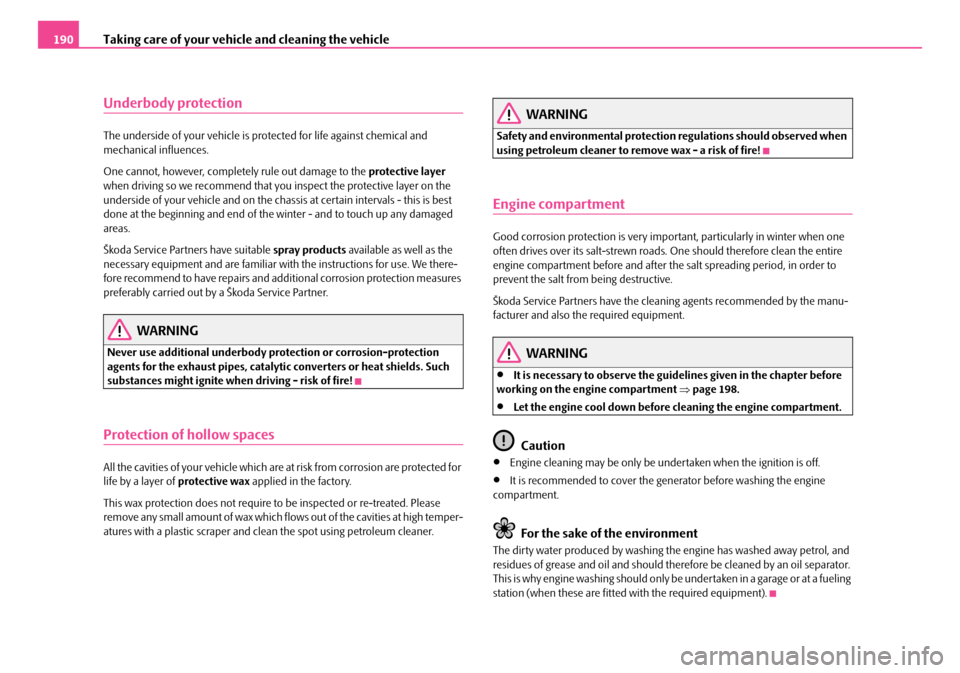
Taking care of your vehicle and cleaning the vehicle190
Underbody protection
The underside of your vehicle is protected for life against chemical and mechanical influences.
One cannot, however, complete ly rule out damage to the protective layer when driving so we recommend that you inspect the protective layer on the underside of your ve hicle and on the chassis at certain intervals - this is best done at the beginning and end of the winter - and to touch up any damaged areas.
Škoda Service Partne rs have suitable spray products available as well as the necessary equipment and are familiar with the instructions for use. We there- fore recommend to have repairs and addi tional corrosion protection measures preferably carried out by a Škoda Service Partner.
WARNING
Never use additional underbody protection or corrosion-protection agents for the exhaust pipes, catalytic converters or heat shields. Such substances might ignite when driving - risk of fire!
Protection of hollow spaces
All the cavities of your vehicle which are at risk from corrosion are protected for life by a layer of protective wax applied in the factory.
This wax protection does not require to be inspected or re-treated. Please remove any small amount of wax which flow s out of the cavities at high temper- atures with a plastic scraper and cl ean the spot using petroleum cleaner.
WARNING
Safety and environmental protection regulations should observed when using petroleum cleaner to remove wax - a risk of fire!
Engine compartment
Good corrosion protection is very import ant, particularly in winter when one often drives over its salt-strewn roads. One should therefore clean the entire engine compartment before and after the salt spreading period, in order to prevent the salt from being destructive.
Škoda Service Partners have the cleani ng agents recommended by the manu- facturer and also the required equipment.
WARNING
•It is necessary to observe the guid elines given in the chapter before working on the engine compartment ⇒page 198.
•Let the engine cool down before cleaning the engine compartment.
Caution
•Engine cleaning may be only be undertaken when the ignition is off.
•It is recommended to cover the generator before washing the engine compartment.
For the sake of the environment
The dirty water produced by washing the engine has washed away petrol, and residues of grease and oil and should therefore be cleaned by an oil separator. This is why engine washing should only be undertaken in a garage or at a fueling station (when these are fitted with the required equipment).
NKO A05Fabia 20.book Page 190 Tuesday, September 26, 2006 8:38 AM
Page 192 of 258
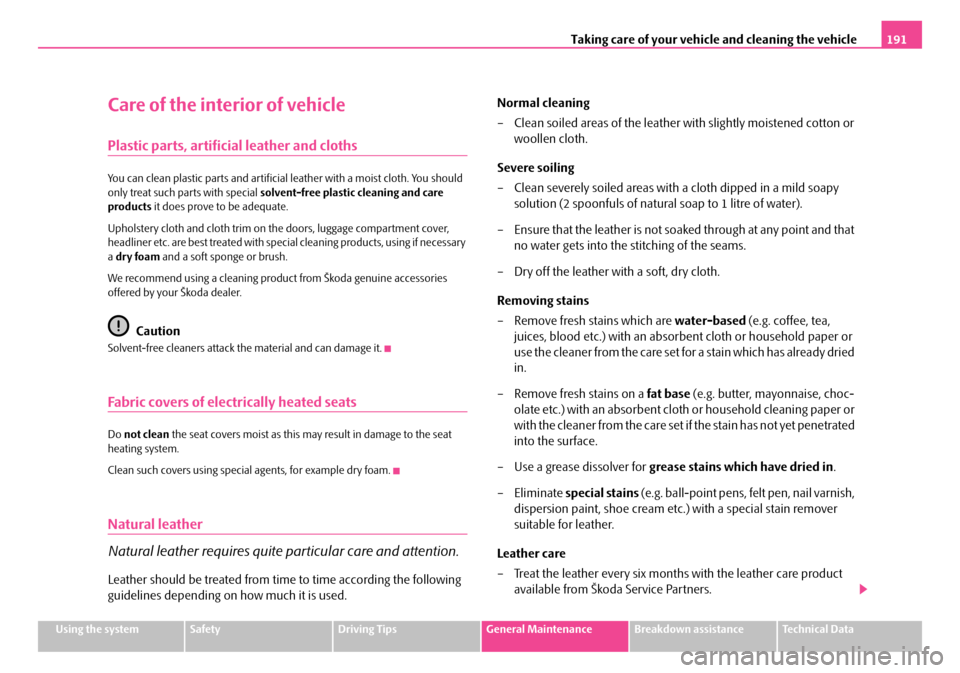
Taking care of your vehicle and cleaning the vehicle191
Using the systemSafetyDriving TipsGeneral MaintenanceBreakdown assistanceTechnical Data
Care of the interior of vehicle
Plastic parts, artificial leather and cloths
You can clean plastic parts and artificial leather with a moist cloth. You should only treat such parts with special solvent-free plastic cleaning and care products it does prove to be adequate.
Upholstery cloth and cloth trim on th e doors, luggage compartment cover, headliner etc. are best treated with spec ial cleaning products, using if necessary a dry foam and a soft sponge or brush.
We recommend using a cleaning prod uct from Škoda genuine accessories offered by your Škoda dealer.
Caution
Solvent-free cleaners attack the material and can damage it.
Fabric covers of elec trically heated seats
Do not clean the seat covers moist as this may result in damage to the seat heating system.
Clean such covers using special agents, for example dry foam.
Natural leather
Natural leather requires quite particular care and attention.
Leather should be treated from time to time according the following
guidelines depending on how much it is used.
Normal cleaning
– Clean soiled areas of the leather with slightly moistened cotton or
woollen cloth.
Severe soiling
– Clean severely soiled areas with a cloth dipped in a mild soapy
solution (2 spoonfuls of natura l soap to 1 litre of water).
– Ensure that the leather is not soak ed through at any point and that
no water gets into the stitching of the seams.
– Dry off the leather with a soft, dry cloth.
Removing stains
– Remove fresh stains which are water-based (e.g. coffee, tea,
juices, blood etc.) with an absorbent cloth or household paper or
use the cleaner from the care set for a stain which has already dried
in.
– Remove fresh stains on a fat base (e.g. butter, mayonnaise, choc-
olate etc.) with an absorbent cloth or household cleaning paper or
with the cleaner from the care set if the stain has not yet penetrated
into the surface.
– Use a grease dissolver for grease stains which have dried in.
–Eliminate special stains (e.g. ball-point pens, felt pen, nail varnish,
dispersion paint, shoe cream etc.) with a special stain remover
suitable for leather.
Leather care
– Treat the leather every six months with the leather care product
available from Škoda Service Partners.
NKO A05Fabia 20.book Page 191 Tuesday, September 26, 2006 8:38 AM
Page 193 of 258
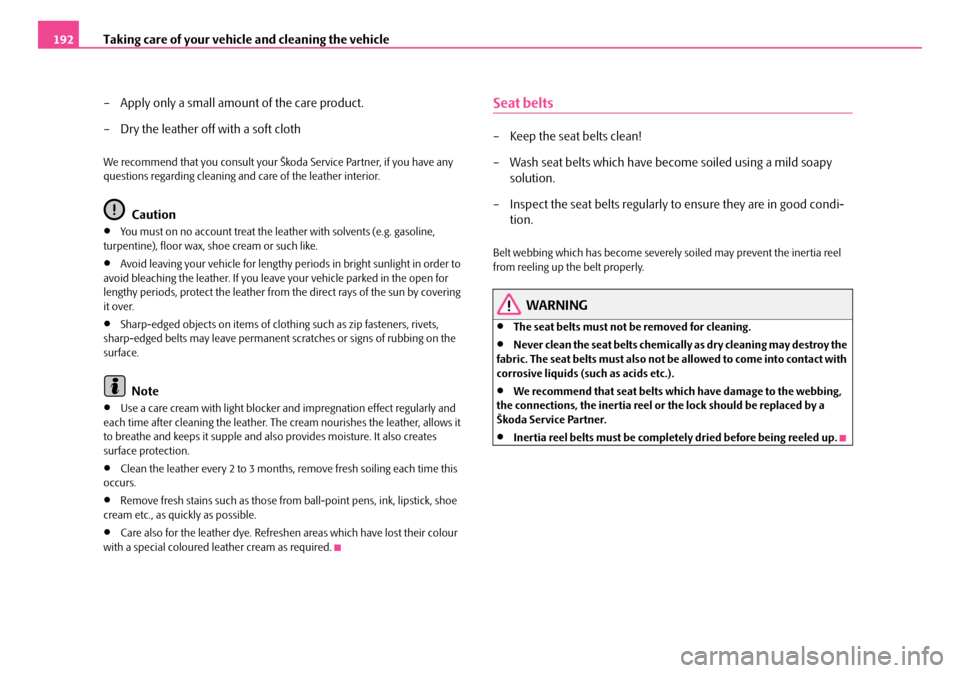
Taking care of your vehicle and cleaning the vehicle192
– Apply only a small amount of the care product.
– Dry the leather off with a soft cloth
We recommend that you consult your Šk oda Service Partner, if you have any questions regarding cleaning and care of the leather interior.
Caution
•You must on no account treat the le ather with solvents (e.g. gasoline, turpentine), floor wax, shoe cream or such like.
•Avoid leaving your vehicle for lengthy pe riods in bright sunlight in order to avoid bleaching the leather. If you leav e your vehicle parked in the open for lengthy periods, protect the leather from the direct rays of the sun by covering it over.
•Sharp-edged objects on items of clothi ng such as zip fasteners, rivets, sharp-edged belts may leave permanent scratches or signs of rubbing on the surface.
Note
•Use a care cream with light blocker and impregnation effect regularly and each time after cleaning the leather. Th e cream nourishes the leather, allows it to breathe and keeps it supple and also provides moisture. It also creates surface protection.
•Clean the leather every 2 to 3 months, remove fresh soiling each time this occurs.
•Remove fresh stains such as those from ball-point pens, ink, lipstick, shoe cream etc., as quickly as possible.
•Care also for the leather dye. Refreshe n areas which have lost their colour with a special coloured leather cream as required.
Seat belts
– Keep the seat belts clean!
– Wash seat belts which have become soiled using a mild soapy
solution.
– Inspect the seat belts regularly to ensure they are in good condi-
tion.
Belt webbing which has become severely soiled may prevent the inertia reel from reeling up the belt properly.
WARNING
•The seat belts must not be removed for cleaning.
•Never clean the seat belts chemically as dry cleaning may destroy the fabric. The seat belts must also not be allowed to come into contact with corrosive liquids (such as acids etc.).
•We recommend that seat belts which have damage to the webbing, the connections, the inertia reel or the lock should be replaced by a Škoda Service Partner.
•Inertia reel belts must be completely dried before being reeled up.
NKO A05Fabia 20.book Page 192 Tuesday, September 26, 2006 8:38 AM
Page 194 of 258
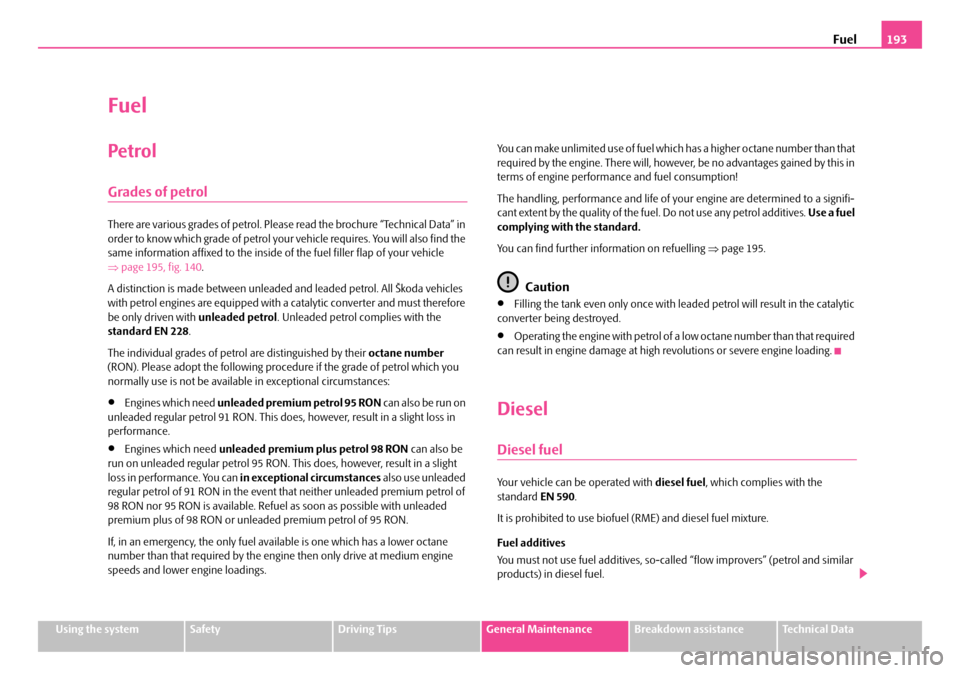
Fuel193
Using the systemSafetyDriving TipsGeneral MaintenanceBreakdown assistanceTechnical Data
Fuel
Petrol
Grades of petrol
There are various grades of petrol. Please read the brochure “Technical Data” in order to know which grade of petrol your vehicle requires. You will also find the same information affixed to the inside of the fuel filler flap of your vehicle ⇒ page 195, fig. 140.
A distinction is made between unleaded and leaded petrol. All Škoda vehicles with petrol engines are equipped with a catalytic converter and must therefore be only driven with unleaded petrol. Unleaded petrol complies with the standard EN 228 .
The individual grades of petrol are distinguished by their octane number (RON). Please adopt the following procedure if the grade of petrol which you normally use is not be availabl e in exceptional circumstances:
•Engines which need unleaded premium petrol 95 RON can also be run on unleaded regular petrol 91 RON. This does, however, result in a slight loss in performance.
•Engines which need unleaded premium plus petrol 98 RON can also be run on unleaded regular petrol 95 RON. Th is does, however, result in a slight loss in performance. You can in exceptional circumstances also use unleaded regular petrol of 91 RON in the event that neither unleaded premium petrol of 98 RON nor 95 RON is available. Refuel as soon as possible with unleaded premium plus of 98 RON or unleaded premium petrol of 95 RON.
If, in an emergency, the only fuel av ailable is one which has a lower octane number than that required by the engine then only drive at medium engine speeds and lower engine loadings.
You can make unlimited use of fuel which has a higher octane number than that required by the engine. There will, however, be no advantages gained by this in terms of engine performance and fuel consumption!
The handling, performance and life of yo ur engine are determined to a signifi- cant extent by the quality of the fu el. Do not use any petrol additives. Use a fuel complying with the standard.
You can find further info rmation on refuelling ⇒page 195.
Caution
•Filling the tank even only once with leaded petrol will result in the catalytic converter being destroyed.
•Operating the engine with petrol of a low octane number than that required can result in engine damage at high revolutions or severe engine loading.
Diesel
Diesel fuel
Your vehicle can be operated with diesel fuel, which complies with the standard EN 590.
It is prohibited to use biofuel (RME) and diesel fuel mixture.
Fuel additives
You must not use fuel additives, so-called “flow improvers” (petrol and similar products) in diesel fuel.
NKO A05Fabia 20.book Page 193 Tuesday, September 26, 2006 8:38 AM
Page 195 of 258
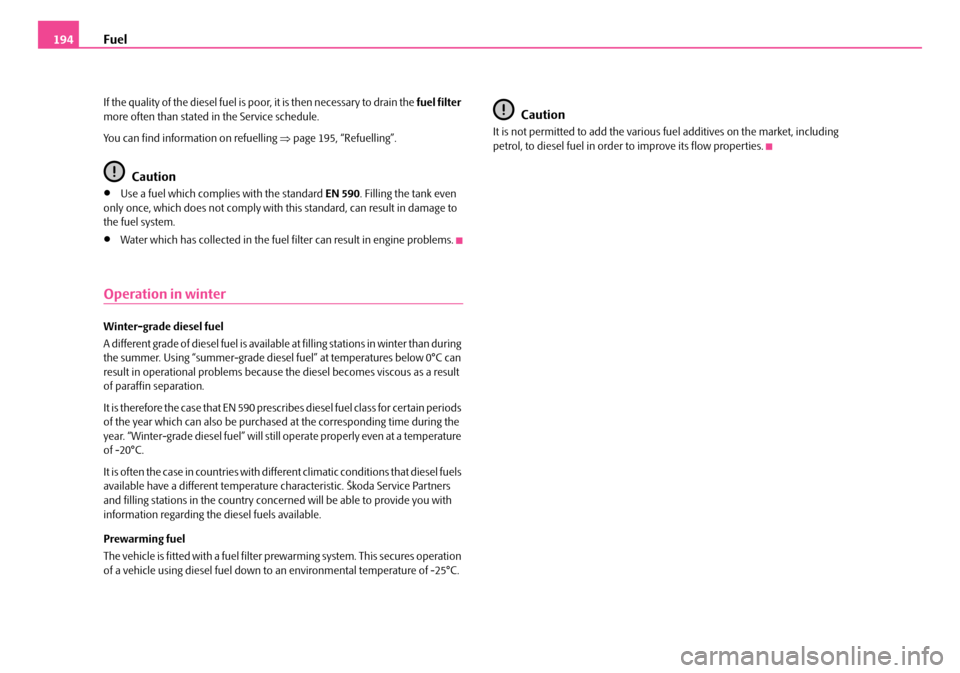
Fuel194
If the quality of the diesel fuel is poor, it is then necessary to drain the fuel filter more often than stated in the Service schedule.
You can find information on refuelling ⇒page 195, “Refuelling”.
Caution
•Use a fuel which complies with the standard EN 590. Filling the tank even only once, which does not comply with th is standard, can result in damage to the fuel system.
•Water which has collected in the fuel fi lter can result in engine problems.
Operation in winter
Winter-grade diesel fuel
A different grade of diesel fuel is available at filling stations in winter than during the summer. Using “summer-grade diesel fuel” at temperatures below 0°C can result in operational problems because the diesel becomes viscous as a result of paraffin separation.
It is therefore the case that EN 590 prescribes diesel fuel class for certain periods of the year which can also be purchase d at the corresponding time during the year. “Winter-grade diesel fuel” will still operate properly even at a temperature of -20°C.
It is often the case in countries with diff erent climatic conditions that diesel fuels available have a different temperature characteristic. Škoda Service Partners and filling stations in the country concer ned will be able to provide you with information regarding the diesel fuels available.
Prewarming fuel
The vehicle is fitted with a fuel filter prewarming system. This secures operation of a vehicle using diesel fuel down to an environmental temperature of -25°C.
Caution
It is not permitted to add the various fuel additives on the market, including petrol, to diesel fuel in order to improve its flow properties.
NKO A05Fabia 20.book Page 194 Tuesday, September 26, 2006 8:38 AM
Page 196 of 258
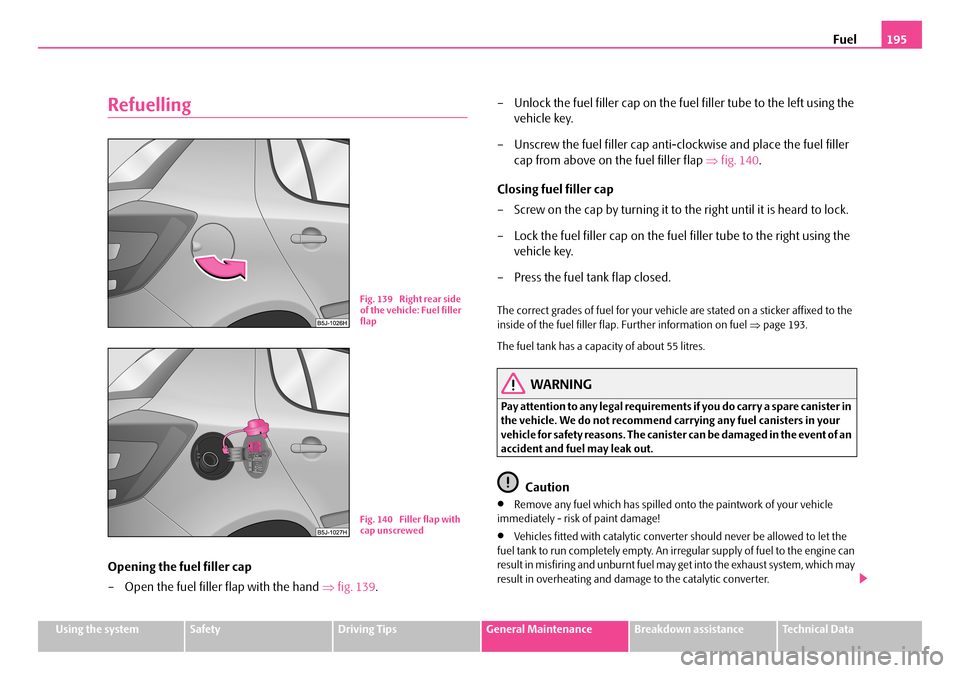
Fuel195
Using the systemSafetyDriving TipsGeneral MaintenanceBreakdown assistanceTechnical Data
Refuelling
Opening the fuel filler cap
– Open the fuel filler flap with the hand ⇒fig. 139.
– Unlock the fuel filler cap on the fuel filler tube to the left using the
vehicle key.
– Unscrew the fuel filler cap anti-clockwise and place the fuel filler
cap from above on the fuel filler flap ⇒fig. 140.
Closing fuel filler cap
– Screw on the cap by turning it to the right until it is heard to lock.
– Lock the fuel filler cap on the fuel filler tube to the right using the
vehicle key.
– Press the fuel tank flap closed.
The correct grades of fuel for your vehicl e are stated on a sticker affixed to the inside of the fuel filler flap. Further information on fuel ⇒page 193.
The fuel tank has a capa city of about 55 litres.
WARNING
Pay attention to any legal requirements if you do carry a spare canister in the vehicle. We do not recommend ca rrying any fuel canisters in your vehicle for safety reasons. The canister can be damaged in the event of an accident and fuel may leak out.
Caution
•Remove any fuel which has spilled onto the paintwork of your vehicle immediately - risk of paint damage!
•Vehicles fitted with cata lytic converter should never be allowed to let the fuel tank to run completely empty. An irregular supply of fuel to the engine can result in misfiring and unburnt fuel ma y get into the exhaust system, which may result in overheating and dama ge to the catalytic converter.
Fig. 139 Right rear side of the vehicle: Fuel filler flap
Fig. 140 Filler flap with cap unscrewed
NKO A05Fabia 20.book Page 195 Tuesday, September 26, 2006 8:38 AM
Page 197 of 258
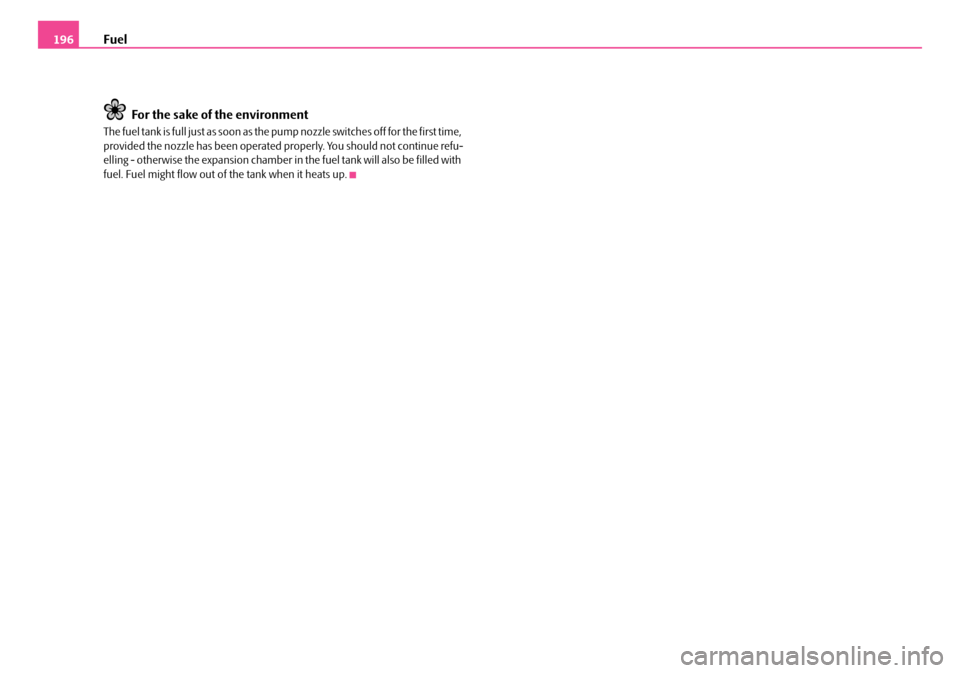
Fuel196
For the sake of the environment
T h e f u e l t a n k i s f u l l j u s t a s s o o n a s t h e p u m p n o z z l e s w i t c h e s o f f fo r t h e f i rs t t i m e , provided the nozzle has been operated pr operly. You should not continue refu- elling - otherwise the expansion chamber in the fuel tank will also be filled with fuel. Fuel might flow out of the tank when it heats up.
NKO A05Fabia 20.book Page 196 Tuesday, September 26, 2006 8:38 AM
Page 198 of 258
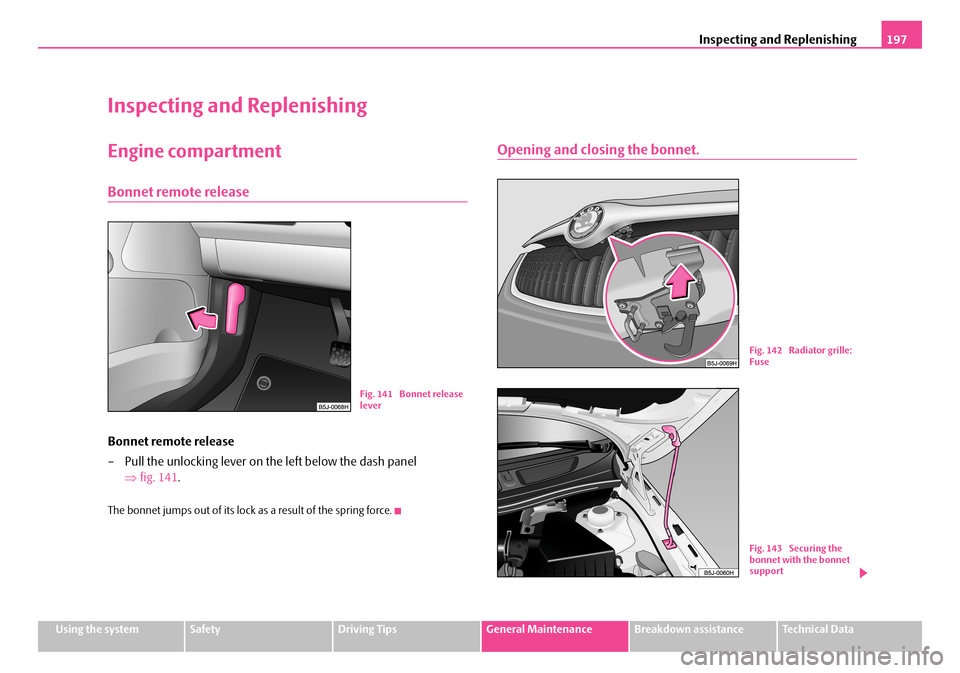
Inspecting and Replenishing197
Using the systemSafetyDriving TipsGeneral MaintenanceBreakdown assistanceTechnical Data
Inspecting and Replenishing
Engine compartment
Bonnet remote release
Bonnet remote release
– Pull the unlocking lever on the left below the dash panel
⇒ fig. 141.
The bonnet jumps out of its lock as a result of the spring force.
Opening and closing the bonnet.
Fig. 141 Bonnet release lever
Fig. 142 Radiator grille: Fuse
Fig. 143 Securing the bonnet with the bonnet support
NKO A05Fabia 20.book Page 197 Tuesday, September 26, 2006 8:38 AM
Page 199 of 258
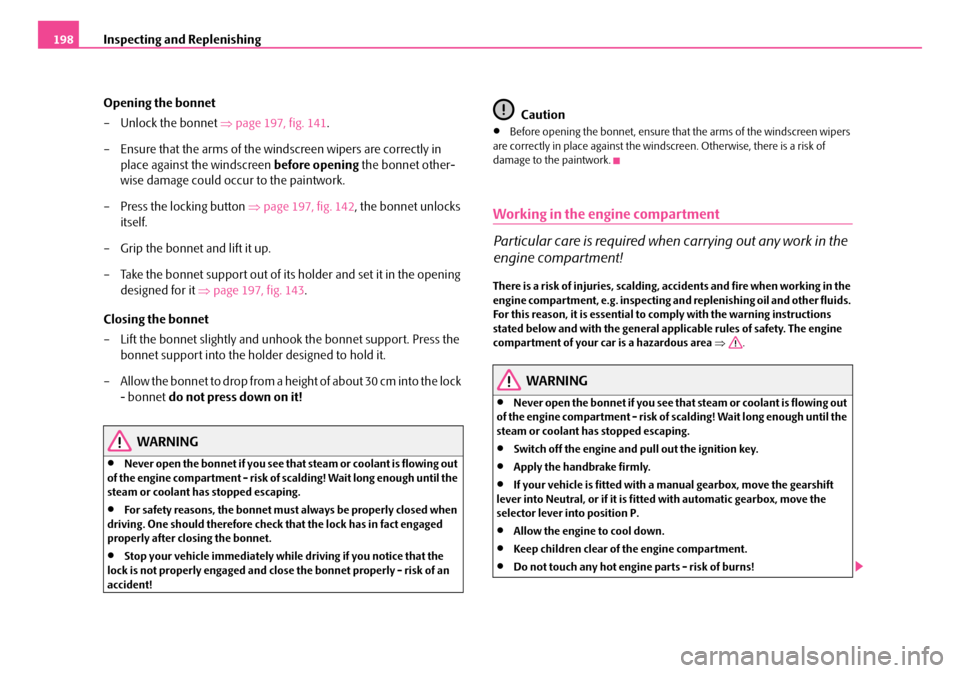
Inspecting and Replenishing198
Opening the bonnet
– Unlock the bonnet ⇒page 197, fig. 141.
– Ensure that the arms of the windscreen wipers are correctly in
place against the windscreen before opening the bonnet other-
wise damage could occur to the paintwork.
– Press the locking button ⇒page 197, fig. 142, the bonnet unlocks
itself.
– Grip the bonnet and lift it up.
– Take the bonnet support out of its holder and set it in the opening
designed for it ⇒page 197, fig. 143.
Closing the bonnet
– Lift the bonnet slightly and unhook the bonnet support. Press the
bonnet support into the holder designed to hold it.
– Allow the bonnet to drop from a height of about 30 cm into the lock
- bonnet do not press down on it!
WARNING
•Never open the bonnet if you see that steam or coolant is flowing out of the engine compartment - risk of scalding! Wait long enough until the steam or coolant has stopped escaping.
•For safety reasons, the bonnet must always be properly closed when driving. One should therefore check that the lock has in fact engaged properly after closing the bonnet.
•Stop your vehicle immediately whil e driving if you notice that the lock is not properly engaged and close the bonnet properly - risk of an accident!
Caution
•Before opening the bonnet, ensure that the arms of the windscreen wipers are correctly in place against the windscreen. Otherwise, there is a risk of damage to the paintwork.
Working in the engine compartment
Particular care is required when carrying out any work in the
engine compartment!
There is a risk of injuries, scalding, accidents and fire when working in the engine compartment, e.g. inspecting and replenishing oil and other fluids. For this reason, it is essential to comply with the warning instructions stated below and with the general appl icable rules of safety. The engine compartment of your car is a hazardous area ⇒.
WARNING
•Never open the bonnet if you see that steam or coolant is flowing out of the engine compartment - risk of scalding! Wait long enough until the steam or coolant has stopped escaping.
•Switch off the engine and pull out the ignition key.
•Apply the handbrake firmly.
•If your vehicle is fitted with a manual gearbox, move the gearshift lever into Neutral, or if it is fitted with automatic gearbox, move the selector lever into position P.
•Allow the engine to cool down.
•Keep children clear of the engine compartment.
•Do not touch any hot engine parts - risk of burns!
NKO A05Fabia 20.book Page 198 Tuesday, September 26, 2006 8:38 AM
Page 200 of 258
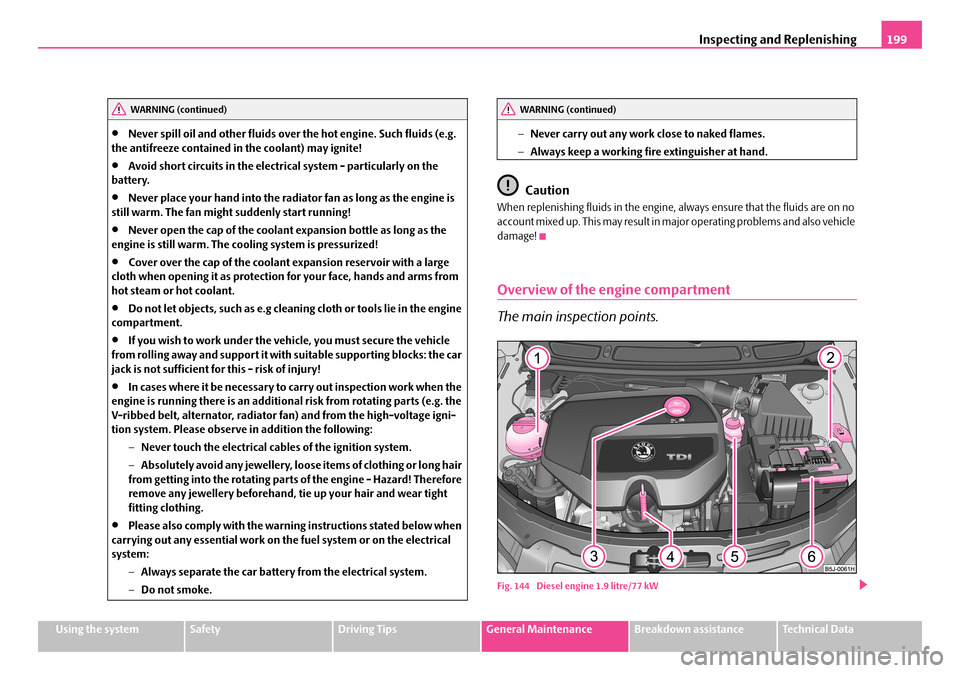
Inspecting and Replenishing199
Using the systemSafetyDriving TipsGeneral MaintenanceBreakdown assistanceTechnical Data
•Never spill oil and other fluids over the hot engine. Such fluids (e.g. the antifreeze contained in the coolant) may ignite!
•Avoid short circuits in the electrical system - particularly on the battery.
•Never place your hand into the radiator fan as long as the engine is still warm. The fan might suddenly start running!
•Never open the cap of the coolant expansion bottle as long as the engine is still warm. The co oling system is pressurized!
•Cover over the cap of the coolant expansion reservoir with a large cloth when opening it as protection for your face, hands and arms from hot steam or hot coolant.
•Do not let objects, such as e.g cleaning cloth or tools lie in the engine compartment.
•If you wish to work under the vehicle, you must secure the vehicle from rolling away and support it with suitable supporting blocks: the car jack is not sufficient for this - risk of injury!
•In cases where it be necessary to carry out inspection work when the engine is running there is an additional risk from rotating parts (e.g. the V-ribbed belt, alternator, radiator fan) and from the high-voltage igni- tion system. Please observe in addition the following:
− Never touch the electrical cables of the ignition system.
− Absolutely avoid any jewellery, loose items of clothing or long hair from getting into the rotating part s of the engine - Hazard! Therefore remove any jewellery beforehand, tie up your hair and wear tight fitting clothing.
•Please also comply with the warnin g instructions stated below when carrying out any essential work on th e fuel system or on the electrical system:
− Always separate the car battery from the electrical system.
− Do not smoke.
− Never carry out any work close to naked flames.
− Always keep a working fire extinguisher at hand.
Caution
When replenishing fluids in the engine, always ensure that the fluids are on no account mixed up. This may result in ma jor operating problems and also vehicle damage!
Overview of the engine compartment
The main inspection points.
Fig. 144 Diesel engine 1.9 litre/77 kW
WARNING (continued)WARNING (continued)
NKO A05Fabia 20.book Page 199 Tuesday, September 26, 2006 8:38 AM